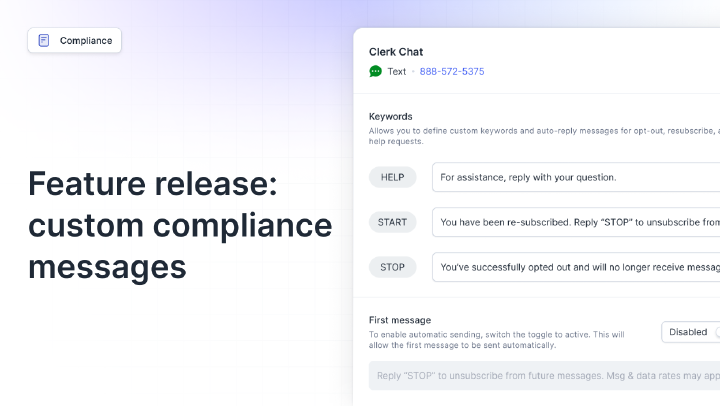Transactional SMS
[trænˈzækʃənəl ˈɛs ˈɛm ˈɛs]Transactional SMS refers to automated text messages businesses send to customers containing essential information about their accounts, orders, or services. Unlike promotional messages, these texts deliver critical updates customers need to complete transactions or stay informed about their business relationships.
Why transactional SMS matters
Transactional SMS creates immediate connections between businesses and customers when timing matters most. These messages achieve near-perfect open rates because recipients expect and value the information they contain. Whether confirming a bank transfer, sharing a delivery update, or sending a password reset code, transactional SMS provides the speed and reliability modern customers demand.
The impact extends beyond simple notifications. Businesses using transactional SMS report significant reductions in customer service inquiries, as proactive updates answer questions before customers ask them. This messaging channel also builds trust by keeping customers informed throughout their journey, from purchase confirmation to final delivery. In an era where customer experience determines competitive advantage, transactional SMS delivers the responsive communication that sets leading businesses apart.
How transactional SMS works
Transactional SMS operates through automated triggers within business systems. When a customer completes an action - placing an order, scheduling an appointment, or requesting a password reset - the system automatically generates and sends a relevant text message. This process typically follows these steps:
Customer action trigger - A customer initiates an action requiring confirmation or notification (purchase, sign-up, account change)
System detection - Business software recognizes the trigger event and pulls relevant customer data including phone number and transaction details
Message generation - The system populates a pre-approved template with specific information like order numbers, appointment times, or verification codes
API transmission - The message routes through an SMS API to telecom carriers for delivery
Instant delivery - Carriers deliver the message to the customer’s phone, typically within seconds
Status tracking - The system logs delivery confirmation and any error messages for troubleshooting
This automation ensures consistency, speed, and accuracy across thousands of daily customer interactions without manual intervention.
Best practices with transactional SMS
Keep messages brief and actionable - Limit texts to essential information only. Include order numbers, dates, and next steps clearly. Avoid unnecessary details that dilute the core message.
Identify your business clearly - Start every message with your company name or recognizable abbreviation. Customers should immediately know who sent the text to build trust and prevent confusion.
Use consistent formatting - Maintain the same structure across all transactional messages. Place key information like codes or tracking numbers prominently for easy scanning and copying.
Time messages appropriately - Send updates when customers expect them. Shipping confirmations should follow order placement quickly, while appointment reminders work best 24-48 hours before scheduled times.
Include relevant contact options - Provide a customer service number or link for questions. Make sure support channels can handle inquiries about the specific transaction mentioned in the message.
Test across carriers and devices - Verify messages display correctly on different networks and phone types. Special characters or formatting may appear differently, affecting readability and professionalism.
Monitor delivery metrics closely - Track success rates, bounce rates, and failure reasons. Quick identification of delivery issues prevents customer frustration and maintains service quality standards.
Real world examples
Common misconceptions
Transactional messages serve informational purposes while promotional messages advertise products or services with different regulations.
Critical transactional messages like security alerts typically cannot be opted out of, unlike marketing communications.
These messages can be sent 24/7 since they contain time-sensitive information customers need immediately.
Automation doesn't determine message type - content and purpose define whether a message is transactional or promotional.
Related terms
In this article:
Ready to use your business number for text messaging?
Thousands of businesses are already experiencing the power of conversational messaging through SMS. Join us. Free trial and paid tiers available.
Get StartedFAQ
Have questions? We've got answers.
Find what you need quickly and clearly with our most frequently asked questions.
Transactional SMS includes order confirmations, shipping updates, appointment reminders, account alerts, password resets, and payment notifications. These messages must be triggered by customer actions or contain essential account information. They cannot include promotional content or marketing calls-to-action. The primary purpose must be informational rather than commercial.
Start by choosing a compliant messaging platform that supports API integration. Register your business and phone numbers for A2P messaging. Create message templates for common transactions. Integrate the SMS API with your existing systems like CRM or e-commerce platform. Test thoroughly before launch and monitor delivery rates to ensure messages reach customers reliably.
Transactional SMS typically costs between $0.01-0.05 per message in the US, with international rates varying by country. Volume discounts often apply for businesses sending thousands of messages monthly. Additional costs may include platform fees, phone number registration, and API usage charges. Many providers offer pay-as-you-go pricing without minimum commitments.
SMS boasts 98% open rates within 3 minutes versus email's 20% open rate over hours. Text messages work without internet access and reach customers instantly on their primary device. However, SMS has character limits and lacks rich media capabilities. Email suits detailed information while SMS excels for urgent, brief notifications requiring immediate attention.
In the US, transactional SMS must comply with TCPA regulations and carrier requirements. Messages need clear sender identification and cannot include promotional content. While explicit opt-in isn't required for purely transactional messages, businesses must honor opt-out requests for non-critical communications. International messaging requires compliance with local regulations like GDPR in Europe.
Register for 10DLC or short code messaging to improve deliverability. Keep messages concise and avoid spam trigger words. Use consistent sender IDs and message formats. Send during appropriate hours for the recipient's timezone. Monitor bounce rates and update invalid numbers promptly. Work with reputable providers who maintain strong carrier relationships for optimal delivery.




